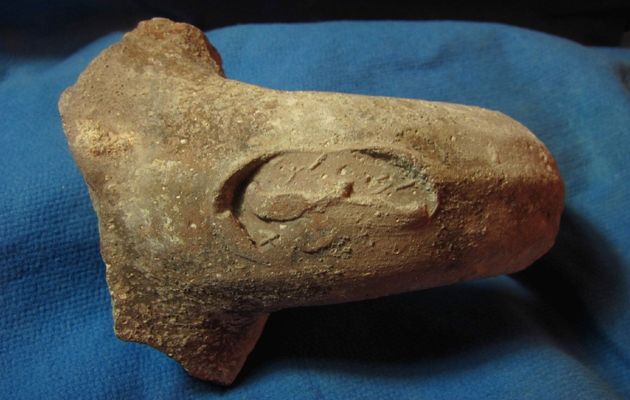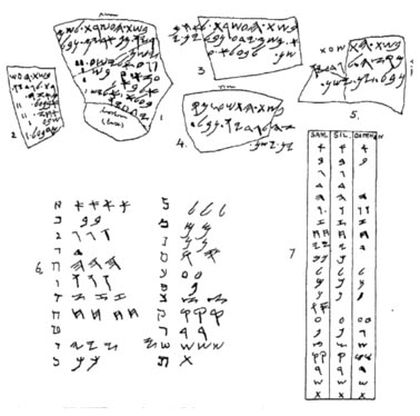The Northern kingdom of Israel and the Southern kingdom of Judah in light of epigraphic evidence
The Samaria Ostraca and LMLK Jar-Handles are two invaluable collections for any scholar intent on understanding the world of iron age Israel and Judah.
26 MARCH 2019 · 16:00 CET

The Samaria Ostraca and LMLK Jar-Handles are two invaluable collections for any scholar intent on understanding the world of iron age Israel and Judah.
Both of these collections are housed currently in the Istanbul Archaeological Museum.
The following is an analysis of these items in an attempt to understand their significance for Biblical studies as well as a possible integration of the data we have in these finds with the Biblical narrative.
LMLK Jar-Handles
The jar-handles with stamps bear a short inscription, “lmlk” which mostly is understood to mean “to/for the king”. The first specimen was discovered in 1869 by Charles Warren. More than 2000 jar-handles bearing the same stamp that have been found to date, all within the borders of the ancient kingdom of Judah.
Aside from the royal inscription each stamp also bears one of four geographical markers: hbrn, zyp, šwkh, or mmšt. The word ‘mmšt’ is a matter of debate. Some consider it to be the word for government, and thus should be understood as Jerusalem.
The dates for these stamps are roughly between the mid 8th century to 587 BCE. One popular theory is that they might have belonged to the reign of Hezekiah around 701 BCE.
One of the most popular explanations as to their use is proposed by Charles Clermont-Ganneau. He came to the conclusion that lmlk jars were used for products which were delivered regularly to the royal storehouses located in the four chief cities of the kingdom.
Consequently, shipments of oil, wine or grain were sent as taxes to be collected by the royal Juhahite administration. However, there are also theories that propose that the place names found in the jar-handles are not the names of the storehouses, rather the places where the jars were manufactured.
Another proposal is that these shipments were not taxes sent to Jerusalem but were tributes sent to the Assyrian administration during Judah’s days of Assyrian vassalage.
Samaria Ostraca
The Samaria Ostraca are a collection of inscribed pot shards that were discovered by the he Harvard expedition on the site of Samaria led by George A.Reisner in 1908/10. They belong to the “Northern” Kingdom of Israel and date around 931-720 BCE.
Most of the ostraca have dates given according to the reign of an unnamed king. The dates are 9th, 10th and 15th year of a king. Since all of the ostaca were found together, there are suggestions that this constituted some sort of archive.
It may also be that they were simply thrown away in a rubbish dump. Rainey suggests that these ostraca should be viewed as scraps or notes which were taken before their content was transcribed into a lost papyrus ledger.
If this is true, we can presume that due to climate conditions in the Levant the pottery shards were able outlive the official papyrus records. The most popular proposals for the unnamed king among scholars seems to be Joash or Jeroboam II.
Several of the inscriptions register transfer of quality wine or fine olive oil from a certain place to a certain person. The topographical data they contain constitute the largest number of Israelite place names found outside the Bible.
Some of these places are thought to be sites of royal vineyards close to the capital. The ostraca also provide us with some insight into ancient scribal practices. Typically the ostraca that document the transmission of oil were written on gray ware while those documenting the arrival of wine were written on red ware.
This suggests a method of sorting the documents. The possible translation of some of these ostraca is as follows:
- Ostracon 1: “In the tenth year. To Shamarayau from Beer-yam, a jar of old wine. Pega son of Elisha, two; Uzza son of…, one; Eliba, one; Baala son of Elisha, one; Jedaiah, one”.
- Ostracon 2: “In the tenth year. To Gaddiyau from Azzo. Abi-Baal, two; Ahaz, two; Sheba, one; Merib-Baal, one”.
- Ostracon 18: “In the tenth year. From Hazeroth to Gadiyau. A jar of fine oil”.
- Ostracon 30: “In the fifteenth year. From Shemida to Hilez son of Gaddiyau. Gera son of Hanniab”.
- Ostracon 60: "In the tenth year. From the vineyard of Yehau-Eli. A jar of fine oil”.
- Ostracon 20, 54, 55 72, 73: “In the tenth year, wine from the vineyard of Tell in a jar of fine oil”.

There are several theories as to their interpretation. One possibility is that these ostraca provide a record of taxes or receipts of taxes sent in shipments of wine or olive oil to the king.
Another theory proposes that these products came from royal vineyards were destined to the nobles or high officials who lived in the capital and were “eating at the king’s table” (e.g., 1.Sam 8:14; 22:7; 2.Sam. 9:9-10; 1.Kgs 18:19).
A recent interpretation by Roger Nam suggests that the record of sophisticated products such as “aged wine” and “washed oil” point to luxury commodities distributed in small quantities that would have been used by king to manipulate his subjects, particularly the nobility, in his favor.
Biblical significance
These discoveries help us create a more complete picture of the Northern and Southern kingdoms of Israel and Judah. Firstly, from the discoveries it seems that the Israelite kingdom was more advanced economically in the VIII century BCE.
This we glean especially from the quality of luxury products that we see recorded in the Ostraca. During the reign of Jeroboam II, to which these ostraca are of related to, Israel had a population of 350,000 and was at its most prosperous period.
Its wealth was built on the trade of olive oil, wine, and possibly horses, with Egypt and especially Assyria.
However, while all the records we have from the Northern kingdom come strictly from the capital city of Samaria; more than 2000 of the lmlk jar-handles found in Judah are distributed around 40 localities.
This data could suggest that wealth in the northern kingdom was centered in the capital and most likely in the hands of a select few, while in the south wealth tended to be more distributed and less centralized.
If Nam’s thesis is to believed, we could postulate that in the Northern kingdom kings used redistributive ‘gifting’ mechanisms as political capital to secure their power.
If we are to read the pre-exilic minor prophets we may postulate that in the north injustice and corruption was centered in and around the capital Samaria, while in the south the problem of injustice and corruption, though present in Jerusalem, tended to primarily reside in rural Judah, especially in the treatment of farmers by land tenants.
Micah’s case is especially interesting, as he is by profession a farmer who lived in the south. He warns both the Northern and Southern Kingdom.
However while the focal point of the judgement to the north is Samaria, in the case of the Southern kingdom- though Jerusalem does have a prominent place- several other towns are also mentioned as recipients of judgement: Gath, Beth-le-aphrah, Shaphir, Zaanan, Beth-ezel, Maroth, Lachish, Moresheth-gath, Mareshah (Micah 1:10-16).
Micah’s focal point when judging the north are the rulers (3:1,9), the false prophets (3:5), rich nobility (6:9-16). His focal point while judging the south are land owners who confiscate the land of the destitute (2:1-2).
Upon surveying the corpus of the pre-exilic minor prophets, an interesting trend can also be perceived. Though many themes are shared across the board and their message is addressed to all people at large, prophets that speak and warn the northern kingdom of impeding judgment seem to have a narrower scope when compared to southern counterparts.
Both Amos and Hosea were contemporaries of Jeroboam II. Amos accuses the ruling class of of Samaria (2:6-16 4:1, 6:1-4), Amaziah the priest (6:10-17), and rich merchants (8:4-6).
After comparing the people of Israel to a prostitute and unfaithful wife through the word of Hosea, God specifically blames the priests for the peoples’ lack of knowledge (4:4-5, 5:1). He also blames the "house of the king” (5:1), the king and princes, who drink and plan intrigue on the table of the king (7:3-7, 8:4).
On the other hand, the prophets that warn or complain regarding the state of the southern kingdom tend to hold a greater scope of society responsible for sins.
Such is the case with Zephaniah, Joel, Habakkuk. Joel who was also a contemporary of Jeroboam II speaks to the drunkards (1:5), farmers and vinedressers (1:11), priests (1:13) and the general populace (1:14) of Judah.
Habakkuk complains of society in the city at large (1:2-4). Zephaniah targets idolatrous civilians and priests (1:4), palace officials (1:8, 3:3), prophets and priests (3:4).
Conclusion
The integration of the current archaeological data and Biblical records seem to provide us with the following picture: Israel was very wealthy, but political power and wealth was centralized in the hand of the few. Idolatry was rampant.
The people had a lack of knowledge because the priests and prophets did not teach the Word of God. The rulers of Israel were proud. Israel, by large, completely disregarded the covenant stipulations which eventually led to their destruction.
Judah, was not as rich, wealth was less centralized, people had more knowledge of the law (especially after Josiah). However land tenants took advantage of the poor. People were complacent and prone to compromise their faith.
Though some kings were faithful to Yahweh, many were insecure and chose to overlook the covenant in pursuit of alliances and false prophets that gave them a false sense of security.
Marc Madrigal is a Board member in the Istanbul Protestant Church Foundation in Turkey.
Bibliography
- Arnold, Bill T. and Bryan E. Beyer, “Readings from the Ancient Near East.” Baker Academic, Grand Rapids, Michigan. 2002
- Lyavdansky, Alexey. «Economic administration in the kingdoms of Israel and Judah (ca. 931 – 587 BCE): epigraphic sources and their interpretations», Comptabilités [Online], 8 | 2016, Online since 20 June 2016, connection on 18 March 2019. URL : http://journals.openedition.org/comptabilites/2024
- Nam, Roger S. (2012) POWER RELATIONS IN THE SAMARIA OSTRACA, Palestine Exploration Quarterly, 144:3, 155-163, DOI: 10.1179/0031032812Z.00000000015
- Noegel, Scott B."The Samaria Ostraca.” Mark W. Chavalas, ed. The Ancient Near East: Historical Sources in Translation London: Blackwell (2006),396-399.
- Suriano Matthew J. “Wine Shipments to Samaria from Royal Vineyards” The Institute of Archaeology of Tel Aviv University, 2016. TEL AVIV Vol. 43, 2016. 99–11
Published in: Evangelical Focus - Archaeological Perspectives - The Northern kingdom of Israel and the Southern kingdom of Judah in light of epigraphic evidence
